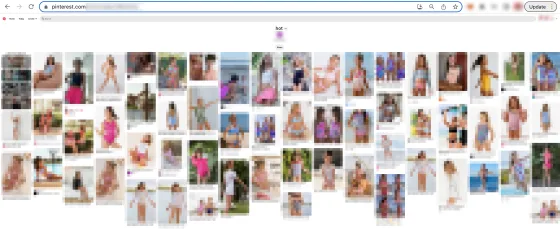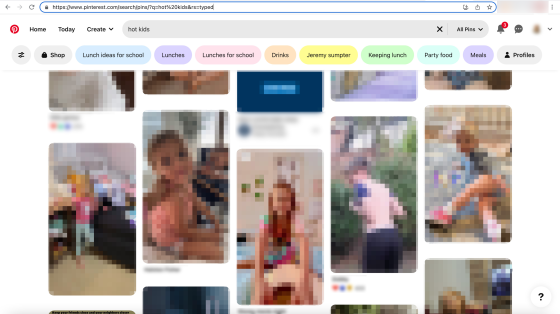
Overview
Pinterest is a popular social media platform that allows users to create and share collections of images called “pins.” The platform has been praised for its user-friendly interface and its wide range of content, but it has also been criticized for its role in the sexual exploitation of children.
What has the Investigation Uncovered?

In a recent investigation by NBC News, it was found that Pinterest’s algorithm is inadvertently curating images of young children for adults who go looking for them. The investigation found that when a user searches for terms related to young girls, such as “schoolgirl” or “cheerleader,” Pinterest is likely to recommend images of young girls in sexually suggestive poses.
The investigation also found that Pinterest is not doing enough to prevent the spread of child sexual abuse material (CSAM) on its platform. NBC News found that Pinterest was hosting hundreds of thousands of images and videos of child sexual abuse, and that the platform should have done more to remove this content.
Pinterest’s response to the investigation has been mixed. The company has said that it is committed to protecting children and that it is working to improve its safety measures. However, some critics have accused Pinterest of not doing enough to address the problem.
The issue of child sexual abuse on social media platforms is a complex one. There is no easy solution, and it is important to remember that social media platforms are not the only places where child sexual abuse material can be found. However, social media platforms do have a responsibility to do everything they can to protect children from harm.
In the case of Pinterest, the company needs to do more to prevent the spread of CSAM on its platform. This includes better screening for CSAM content, more robust reporting mechanisms, and increased transparency about how the company is handling this issue.
Parents also need to be aware of the risks of child sexual abuse on social media platforms. It is important to talk to children about online safety and to monitor their online activity. Parents should also consider using parental controls to restrict their children’s access to certain content.
The sexual exploitation of children is a serious problem, and it is important to do everything we can to protect them. Social media platforms have a role to play in this effort, and they need to do more to prevent the spread of CSAM on their platforms.
How Pinterest’s Algorithm Curates Images of Young Girls

Pinterest’s algorithm is designed to recommend content to users based on their interests. However, the algorithm can also be used to curate images of young girls for adults who go looking for them.
In the NBC News investigation, it was found that when a user searched for terms related to young girls, such as “schoolgirl” or “cheerleader,” Pinterest was likely to recommend images of young girls in sexually suggestive poses. This is because the algorithm is trained on a massive dataset of images, and it learns to associate certain terms with certain types of content.
For example, if the algorithm sees that a lot of users are searching for images of “schoolgirls” and “cheerleaders,” it will start to recommend more images of young girls in these poses. This can create a feedback loop, where the more users search for these terms, the more images of young girls in these poses the algorithm will recommend.
Is Pinterest Doing Enough to Prevent the Spread of CSAM?
Pinterest has a policy against child sexual abuse material, and the company says that it is committed to removing this content from its platform. However, NBC News found that Pinterest was hosting hundreds of thousands of images and videos of child sexual abuse.
Part of the problem is that Pinterest’s automated systems are not very good at detecting CSAM. The company relies on users to report this content, but many users are unaware of the problem or are afraid to report it.
Pinterest also does not have a robust human review process for CSAM content. The company says that it has a team of human reviewers who are responsible for reviewing flagged content, but the team is small and overwhelmed.
As a result of these problems, CSAM content is able to remain on Pinterest for long periods of time. This is a serious problem, as it allows child sexual abusers to access this content and potentially harm children.
What Parents Can Do to Protect Their Children
Parents need to be aware of the risks of child sexual abuse on social media platforms. It is important to talk to children about online safety and to monitor their online activity. Parents should also consider using parental controls to restrict their children’s access to certain content.
Here are some tips for parents to protect their children from child sexual abuse on social media:
- Talk to your children about online safety. Start talking to your children about online safety when they are young. Teach them about the dangers of talking to strangers online, sharing personal information, and posting inappropriate photos or videos.
- Monitor your children’s online activity. Regularly check your children’s social media accounts and devices to make sure they are not being exposed to harmful content.
- Use parental controls. Parental controls can be used to restrict your children’s access to certain websites and content.
- Report child sexual abuse material. If you see child sexual abuse material on social media, you should report it to the platform immediately. You can also report it to the National Center for Missing and Exploited Children (NCMEC) at 1-800-THE-LOST (1-800-843-5678).
By taking these steps, you can help to protect your children from child sexual abuse on social media.
Conclusion
Child sexual abuse is a serious problem, and it is important to do everything we can to protect children. Social media platforms have a role to play in this effort, and they need to do more to prevent the spread of CSAM on their platforms. Parents also need to be aware of the risks of child sexual abuse on social media and take steps to protect their children. By working together, we can help to keep children safe online.
Read the full article on NBC News.
